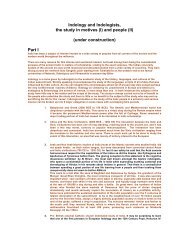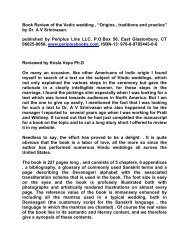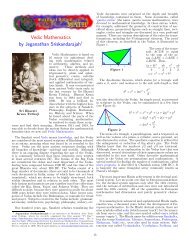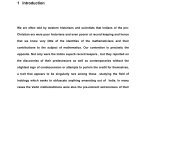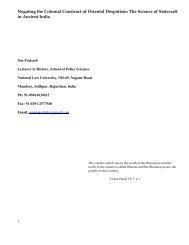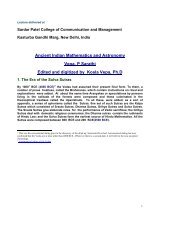The Dhaarmik Traditions - Indic Studies Foundation
The Dhaarmik Traditions - Indic Studies Foundation
The Dhaarmik Traditions - Indic Studies Foundation
You also want an ePaper? Increase the reach of your titles
YUMPU automatically turns print PDFs into web optimized ePapers that Google loves.
still the official version of History in Indian text books) is a tribute to the farsightedness<br />
and tenacity of successive British administrators and scholars who always put British<br />
national interest before every other criterion including the truth.<br />
65<br />
66 Iranian peoples <strong>The</strong> ancient Iranians or Avestans, the people who composed the Avesta, have much in<br />
common with the Vedics. In fact it is believed by some that the Iranians are descended<br />
from the Druhyus. <strong>The</strong> language of the Avesta is easily discernible to those familiar with<br />
Sanskrit and the names of Persian Kings (the original names not the Greek version we<br />
learned in English history books ) For instance the Sanskrit or Iranian version of Darius<br />
is Druhyu.<br />
67 Jnana Yoga<br />
ज्नान<br />
the path of knowledge Jñāna (also spelled "Gyāna"; Devanagari घ्यान) is the Sanskrit<br />
term for knowledge. In Hinduism it means true knowledge, PAra Vidya, the knowledge<br />
that one's self atman is Ultimate Reality Brahman. In Buddhism, it refers to pure<br />
awareness that is free of conceptual encumbrances, and is contrasted with Vijnana,<br />
which is a moment of 'divided knowing'. Jnana yoga is one path (marga) towards<br />
moksha (liberation), while Yoga offers different paths for different temperaments such as<br />
Bhakti and Karma Yoga.<br />
68 Jivanmukta Adi Sankara gives the true definition of a Jivanmukta - <strong>The</strong> great souls he says , calm<br />
and tranquil, live, regenerating the world like the spring; and themselves having crossed<br />
the ocean of embodied existence, and death, help those who struggle, for the same end,<br />
without thew least trace of personal motives or advantage<br />
69 Jyotisha one of the 6 Vedangas, also known as the science of light .It includes the study of the<br />
motion of Celestial Objects or Astronomy and the effects of the forces arising from<br />
these bodies and their effects on the human mind. It is the hypothesis of Vedic<br />
Astrology that such effects can be predicted by studying the relative location of the<br />
planets and the stars . Jyotisha is often discussed as the instructional element of the Rig<br />
Veda, and as such is a Vedangas, or "body part" of the Vedas. Jyotisha is called the Eye<br />
of the Veda, for its believed ability to view both phenomenal reality and wisdom itself.<br />
Part of a larger Vedic curriculum including mathematics, architecture, medical and<br />
military applications.<br />
72 Kalpasutras constitutes part of the Vedanga consists of Grhyasutras, Dharmasutras, Sulvasutras,<br />
Srautasutras.



